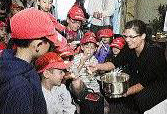New Memento development offers affordable homeas in a great aslocation
LENA SIN
Province

Memento’s great location provides easy access to SkyTrain, the Lougheed Highway, TransCanada Highway, Brentwood Mall and local schools. Photograph by: Arlen Redekop, The Province
When sales of the master-planned Brentwood Gate community outpaced expectations by two to three years, developer Ledingham McAllister knew they were on to a good thing.
So naturally, they hopped across the street and acquired more land in this key Burnaby location in a bid to meet the high demand for the neighbourhood.
Now, two years later, Memento, a West Coast-inspired craftsman low-rise building, is ready for its debut.
The grand opening is scheduled for Sept. 12 and, with the development nearly completed, buyers will get to see exactly what’s on offer.
“They get to walk through the home, they get to see the view, the excellent finishing. None of it is left to guesswork,” says Manuela Mirecki, senior vice-president of marketing for Ledingham McAllister.
Memento is located on Beta Avenue at Lougheed Highway, two blocks east of Willingdon Avenue and within minutes of the SkyTrain station and Brentwood Mall.
Across the street is the Brentwood Gate community, comprised of seven buildings, which sold quickly when the first phase launched in 2006 and now has less than half a dozen units left.
“The response to that community was unbelievable,” says Mirecki.
“So because of that, we immediately recognized there’s a huge demand for this neighbourhood.”
With the success of Brentwood Gate, the long-time Vancouver developer had the confidence to continue with the construction of Memento, even through 2008, when many B.C. developers were halting projects in the wake of an economic recession.
Mirecki says the location has been one of the biggest draws for buyers.
“It just makes logical sense in terms of access to post-secondary education, to the schools that are nearby, to shopping, public transit and the highway. You’re literally right in the hub of accessing everything in the Lower Mainland, but you’re still in a solidly residential neighbourhood that’s as close to Vancouver as you can get.”
Memento has 87 units, with the smallest condos at 687 square feet and starting at $269,900.
While part of the L-shaped building fronts on to Lougheed, most of the condos are positioned along Beta Avenue to maximize privacy. The inner courtyard, with south facing views of Burnaby, is surprisingly quiet while the architecture is heavy on timber details and stone columns in an ode to classic West Coast style.
Inside, the suites all have either patios or balconies, electric fireplaces and kitchens equipped with stainless steel appliances and granite countertops.
The furnishings in the show suites tell the story of whose buying: The two-bedroom suite of 800 sq. ft. comes with two bathrooms and is furnished to show how a small family could comfortably fit in the space.
Meanwhile, the one-bedroom and den is feminine, furnished with designer, Burberry accents.
“If the homes are designed appropriately and sized appropriately, there’s no reason a small family can’t live in these homes,” says Mirecki. “[And] single women is a trend that we’ve definitely seen. It’s actually women in general. Those that are in committed long-term relationships, they are definitely the drivers to settle down to make the financial decision to say ‘You know what, we’re gonna put down roots.'”
Mirecki believes potential buyers of Memento will be similar to those who bought at Brentwood Gate — crossing all age groups and ethnicities, from first-time home buyers to empty nesters downsizing, but who share the common desire to live in homes they buy.
THE FACTS
What: Memento, 87 condos.
Where: 2088 Beta Ave.
(at Lougheed), Burnaby.
Developer: Ledingham
McAllister
Builder: Marcon
Sizes: One bedroom plus den from 687 to 770 sq. ft.; two bedrooms at 805 sq. ft.; two bedrooms plus den from 869 sq. ft. to 915 sq. ft.
Prices: From $269,900
Open: Grand opening is Sept. 12. The sales centre opens daily from noon to 6 p.m. (except Fridays) at 2088 Beta, Burnaby.
More information: www.ledmac.com/memento
© Copyright (c) The Province







